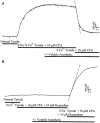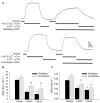Volatile anaesthetic effects on Na+-Ca2+ exchange in rat cardiac myocytes
- PMID: 11283227
- PMCID: PMC2278516
- DOI: 10.1111/j.1469-7793.2001.0091g.x
Volatile anaesthetic effects on Na+-Ca2+ exchange in rat cardiac myocytes
Abstract
We examined the influence of two clinically relevant concentrations (1 and 2 MAC (minimum alveolar concentration)) of halothane and sevoflurane on both efflux and reverse modes of Na+-Ca2+ exchange (NCX) in enzymatically dissociated adult rat cardiac myocytes. We hypothesised that a volatile anaesthetic-induced decrease in myocardial contractility is mediated by a reduction in intracellular calcium concentration ([Ca2+]i) via inhibition of NCX. Cells were exposed to cyclopiazonic acid and zero extracellular Na+ and Ca2+ to block sacroplasmic reticulum (SR) re-uptake and NCX efflux, respectively. As [Ca2+]i increased under these conditions, extracellular Na+ was rapidly (< 300 ms) reintroduced in the presence or absence of a volatile anaesthetic to selectively promote Ca2+ efflux via NCX. Other cells exposed to cyclopiazonic acid and ryanodine to inhibit SR Ca2+ re-uptake and release were Na+ loaded in zero extracellular Ca2+. The reintroduction of extracellular Ca2+ was used to selectively activate Ca2+ influx via NCX. Compared to controls, both 1 and 2 MAC halothane as well as sevoflurane reduced NCX-mediated efflux. The reduction in NCX-mediated influx was concentration dependent, but comparable between the two anaesthetics. Both anaesthetics at each concentration also shifted the relationship between extracellular Na+ (or extent of Na+ loading) and NCX-mediated efflux (or influx) to the right. These data indicate that despite inhibition of NCX-mediated Ca2+ efflux, volatile anaesthetics produce myocardial depression. However, the inhibition of NCX-mediated Ca2+ influx may contribute to decreased cardiac contractility. The overall effect of volatile anaesthetics on the [Ca2+]i profile is likely to be determined by the relative contributions of influx vs. efflux via NCX during each cardiac cycle.
Figures







Similar articles
-
Mechanisms underlying greater sensitivity of neonatal cardiac muscle to volatile anesthetics.Anesthesiology. 2002 Apr;96(4):893-906. doi: 10.1097/00000542-200204000-00017. Anesthesiology. 2002. PMID: 11964597
-
Differential inhibition of neuronal Na+-Ca2+ exchange versus store-operated Ca2+ channels by volatile anesthetics in pheochromocytoma (PC12) cells.Anesthesiology. 2005 Jul;103(1):93-101. doi: 10.1097/00000542-200507000-00016. Anesthesiology. 2005. PMID: 15983461
-
Halothane and sevoflurane inhibit Na/Ca exchange current in rat ventricular myocytes.Br J Anaesth. 2005 Sep;95(3):305-9. doi: 10.1093/bja/aei185. Epub 2005 Jul 1. Br J Anaesth. 2005. PMID: 15994848
-
Cardiac sodium-calcium exchange and efficient excitation-contraction coupling: implications for heart disease.Adv Exp Med Biol. 2013;961:355-64. doi: 10.1007/978-1-4614-4756-6_30. Adv Exp Med Biol. 2013. PMID: 23224894 Free PMC article. Review.
-
Action potential duration modulates calcium influx, Na(+)-Ca2+ exchange, and intracellular calcium release in rat ventricular myocytes.Ann N Y Acad Sci. 1996 Apr 15;779:417-29. doi: 10.1111/j.1749-6632.1996.tb44817.x. Ann N Y Acad Sci. 1996. PMID: 8659858 Review.
Cited by
-
Conventional Echocardiography and Two-Dimensional Speckle Tracking in Healthy Sevoflurane-Anesthetized Dogs Undergoing Continuous Rate Infusion of Nalbuphine.Vet Med Int. 2020 Jun 8;2020:9278751. doi: 10.1155/2020/9278751. eCollection 2020. Vet Med Int. 2020. PMID: 32566120 Free PMC article.
References
-
- Bers DM, Bassani JWM, Bassani RA. Na-Ca exchange and Ca fluxes during contraction and relaxation in mammalian ventricular muscle. Annals of the New York Academy of Sciences. 1996;779:430–442. - PubMed
-
- Blanck TJJ, Hemmings HC, Paroli L, Xu F. Pumps, exchangers, and transporters. In: Yaksh TL, Lynch C, Zapol WM, Maze M, Biebuyck JF, Saidman LJ, editors. Anesthesia: Biologic Foundations. Philadelphia: Lippincott-Raven; 1997. pp. 287–299.
-
- Blaustein MP, Lederer WJ. Sodium/calcium exchange: its physiological implications. Physiological Reviews. 1999;79:763–854. - PubMed
Publication types
MeSH terms
Substances
Grants and funding
LinkOut - more resources
Full Text Sources
Research Materials
Miscellaneous

